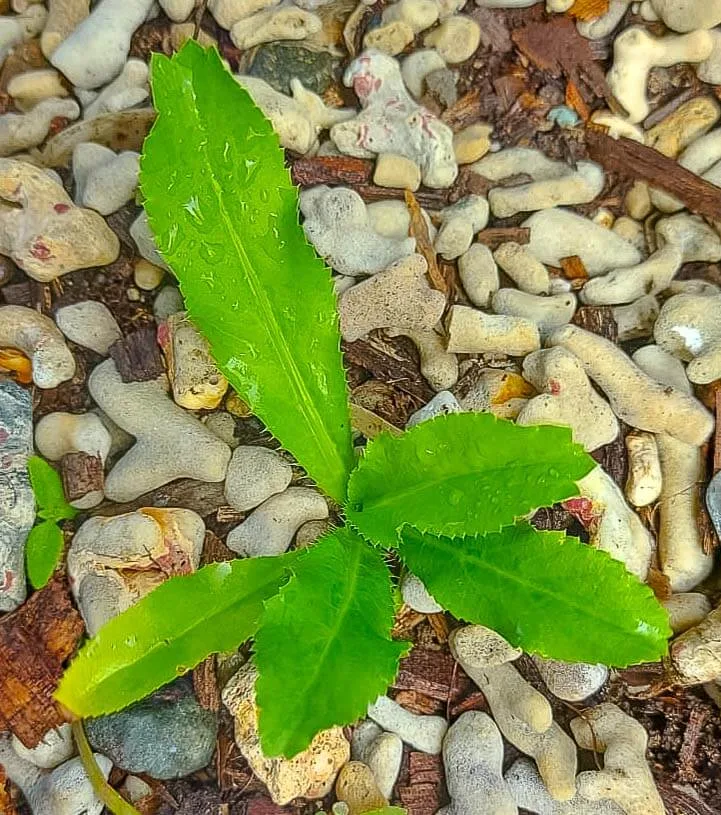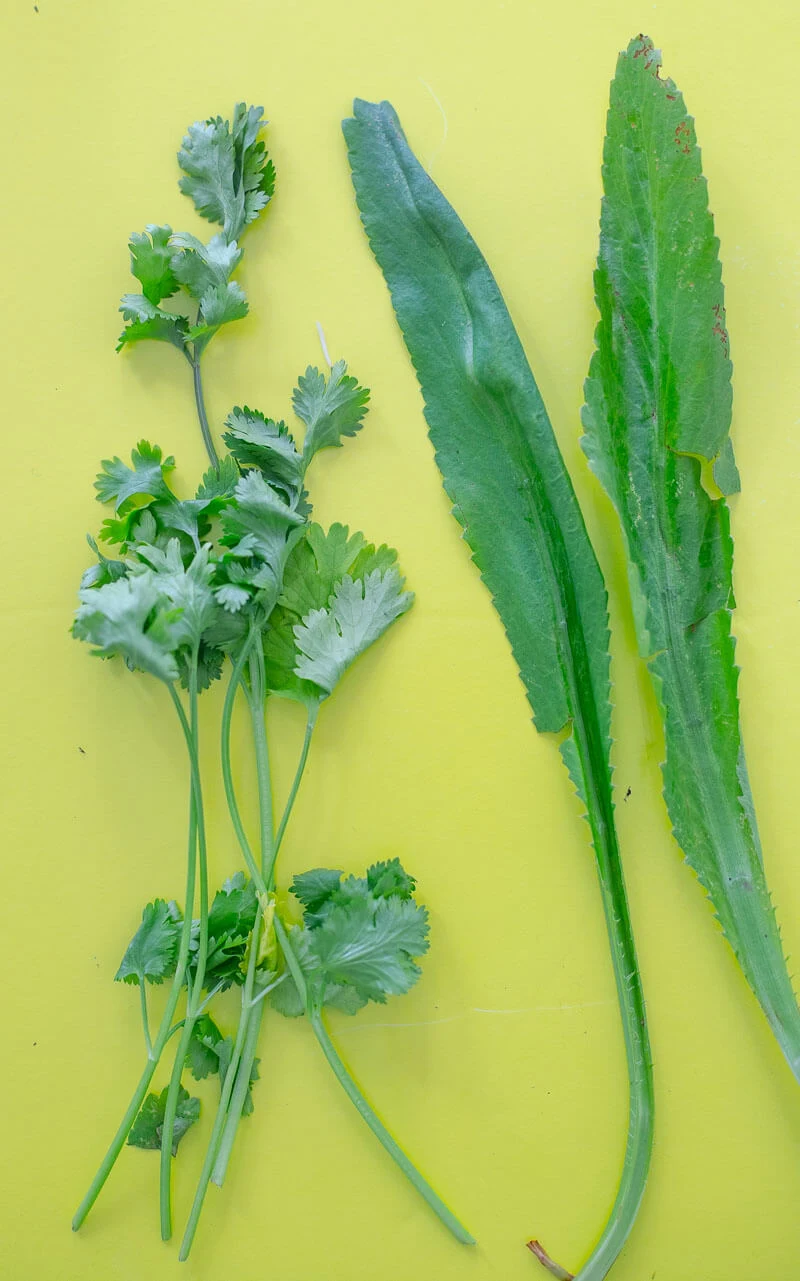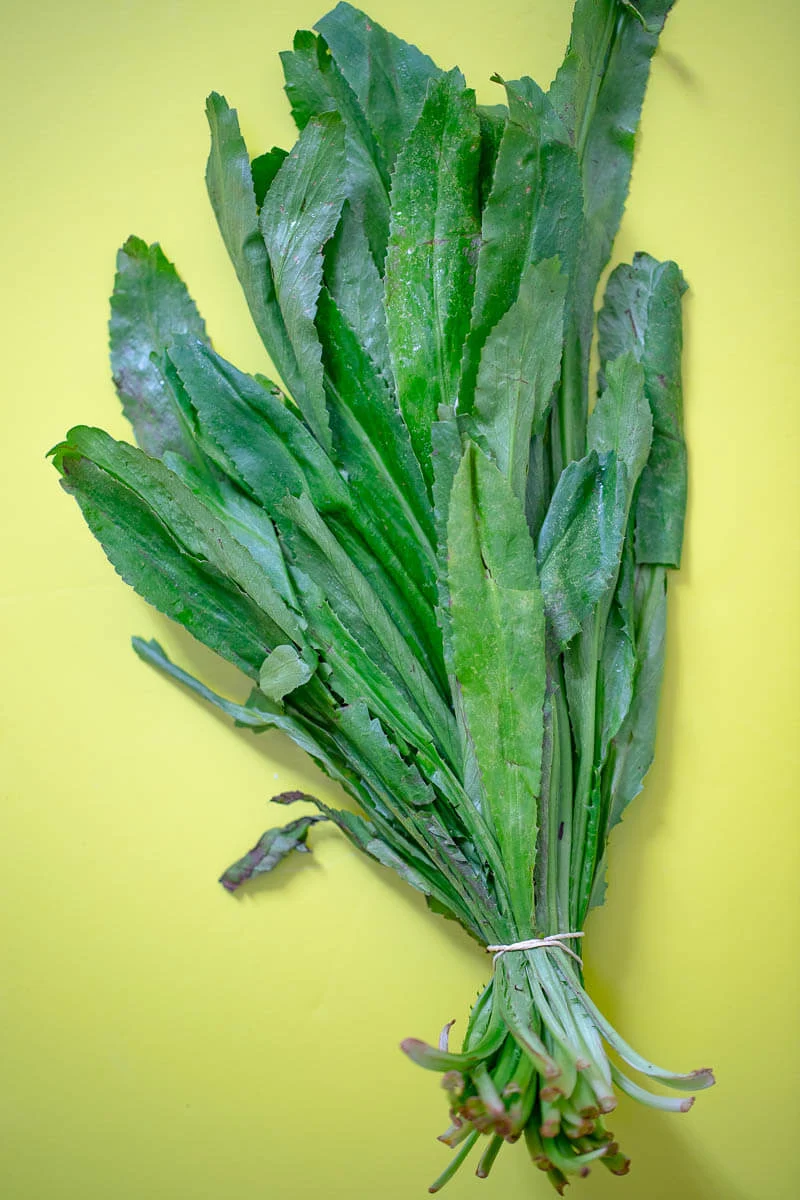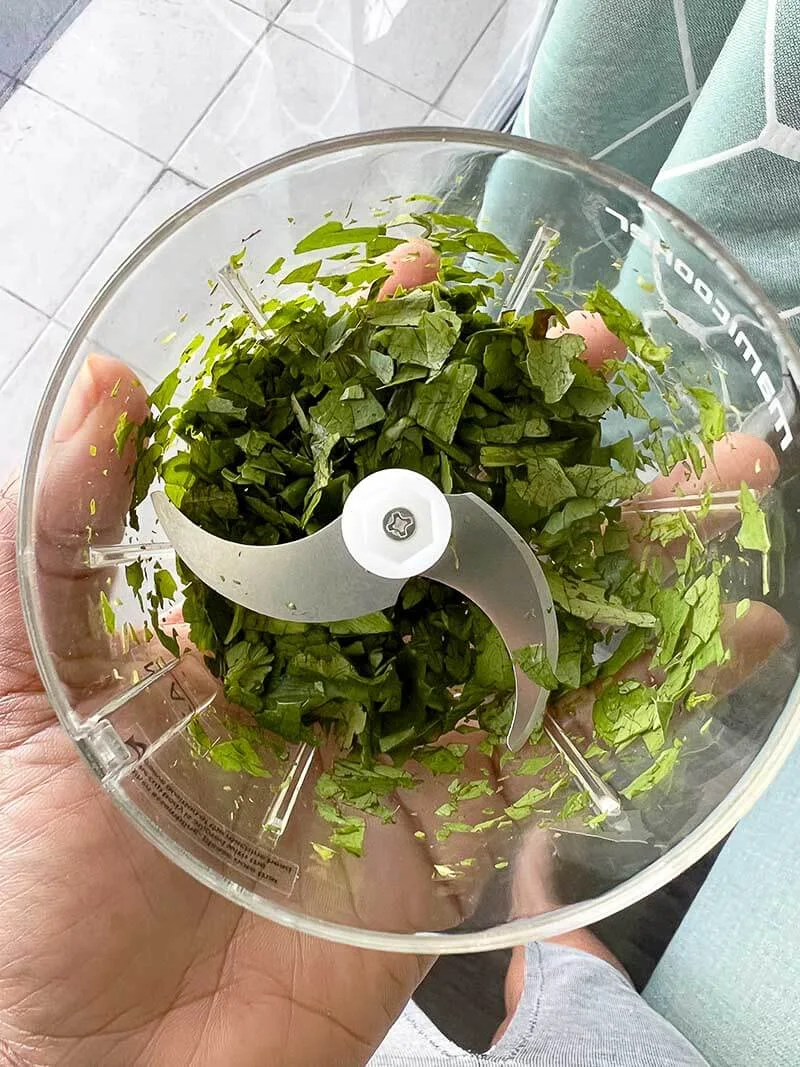What is chadon beni?
6.6.23
| Recipe by Renz
In the Caribbean, we cook with a lot of fresh aromatic herbs. These make up the
flavor profile of all our foods. A very common one, especially in Trinidad and
Tobago is chadon beni. Learn what this herb looks like, tastes like, and the
best uses.
Chadon Beni (along with a few other names including shadow benny or shado beni or culantro) is a popular herb in Latin America and Caribbean countries, is used heavily in cooking.
It is used in various ways for cooking and is a great way to add some flavor to dishes, either as part of the seasoning, the garnish, or in sauces and marinades.
We commonly use it in dishes like stews, curries, marinades, and chutneys. It pairs well with meats, seafood, vegetables, and even fruits, enhancing the overall taste of the dish.
In Caribbean cuisine, it is highly valued for its ability to add depth and flavor to traditional dishes. It is particularly popular in dishes where it contributes to unique and spicy flavors, one great example is chadon beni sauce.
It is such an easy way to add a bit of authenticity to your dishes, especially when cooking traditional stews and casseroles.
Shado beni/shadow benny, is known for its unique pungent and intense flavor and versatile uses in cooking, it is an essential ingredient in many traditional dishes.
When it comes to appearance, this herb has long, serrated leaves with a shiny surface. The leaves are vibrant green in color and grow in stacks, making them easy to harvest. It also produces small green flowers, which add an extra touch of color and beauty to its overall appearance.
Sometimes I have seen the leaves be shorter and I think this happens when there is a dry spell but they are getting a lot of sunlight. You will see them with long leaves when they are actually in areas where they are getting partial shade.
The leaves are often compared to those of cilantro, but the two are not the same. While cilantro has a more delicate flavor, shadow beni is known for its strong, pungent taste that can easily overpower other ingredients in a dish.
One unique aspect of chadon beni is its nickname "fit weed." This is because the herb can grow almost anywhere, even in poor soil conditions, and requires minimal care. Its resilience and versatility make it a popular choice for home gardeners and professional chefs alike.
Apart from its culinary uses, chadon beni is also believed to have various medicinal benefits.
It is thought to help reduce high blood pressure, aid in digestive issues, and even treat snake bites and infertility complications in men. The herb is often used in natural remedies for various health issues, such as headaches, fever, and inflammation. Take a look at this study that goes into a bit more detail about the health benefits of shado beni.
However, it's important to note that more research is needed to fully understand its potential medicinal properties.
It is also very popular in gardening circles. The plant is easy to grow and requires little maintenance, making it a great choice for anyone looking to grow their own culinary herbs. Its long shelf life also makes it a great addition to mixed herb packages or as part of an aromatic herb garden.
Overall, Chadon Beni is a versatile herb with a range of uses and benefits. Whether you're looking for a bold flavor in the kitchen or natural remedies for common ailments, this herb is definitely worth exploring.
This herb can be used in various ways in cooking to add a distinct flavor to your dishes. I love using it in different ways. Here are some of the ways that I like to use it when cooking dishes:
Remember, the flavor of this herb can be quite potent, so start with a small amount and adjust according to your taste preferences.
When it comes to using fresh herbs in your cooking, buying and storing them properly will ensure that you get the most out of their flavor and aroma. Here are some tips on buying the herb.
Chadon Beni can be found in most Caribbean grocery stores and markets. If you need help finding it locally, you can also purchase it online. Make sure to also look for it with the different names.
When buying fresh chadon beni in the stores, look for green, shiny leaves with a strong fragrance. Avoid leaves that are yellow or wilted, and have dark spots as they may be old or damaged. Avoid any that look like they are wilting or discolored. If you do notice any of these things then it won’t be as fresh as you want it to be, and will not have the level of flavor you expect.
Here are a few places to consider when looking to purchase:
Once you've brought your chadon beni home, it's important to store it properly to ensure maximum freshness. If you follow these tips, you'll be able to enjoy fresh Chadon Beni in your cooking for weeks to come.
If you plan on using it within a few days, you can wrap the fresh leaves in a damp paper towel and place them in a plastic bag in the refrigerator. This will keep the leaves fresh and hydrated until you can use them.
If you want it to last longer, you can also freeze it. Simply chop the leaves and place them in a freezer-safe container or plastic bag. It can be frozen for up to 6 months, however, the longer it's frozen, the more its flavor and aroma will diminish.
Another option is to dry it. This is a great way to preserve its flavor and aroma for even longer. Many people love the convenience of dried herbs, and you may be wondering whether you could enjoy the same level of flavor from the chado beni when it is dried. However, you will always get the best flavor by using this herb fresh. When dried, the flavor does diminish, so you won’t get that level of intensity as you would if you used fresh leaves.
I sometimes dry my own. You can either use your dehydrator or your oven. Wash the leaves and remove any debris or damaged parts. Then pat dry the leaves, removing as much moisture as possible. You can even wrap the washed leaves in a paper towel and leave them in the fridge overnight so that it helps remove any excess moisture.
Then place the leaves on a wire wrack (wire rack on top of a tray) and put them in your preheated oven (250) for about 2 - 4 hours or until dried. The whole leaf will be crispy.
Once done you can crush or grind and store in an airtight container.
Another method that I have not tried myself, is to tie a bunch of fresh leaves together with string and hang them upside down in a cool, dry place for 1-2 weeks. Once the leaves are dry and brittle, you can crumble them and store them in an airtight container in a cool, dry place.
However you choose to use it, it is important to make sure you pick the best ones and store them properly to make the most of their flavor and aroma.
Even though we Trini folks popularly call this herb by one name, it is known by different names in different regions. Let's explore some of the other names that are used around the world.
As I mentioned one of the most common names for this herb is chadon beni. It might be spelled as shado beni or shadow benny. This name is widely used in Trinidad and Tobago, where it is considered an essential ingredient in many dishes. You might also hear it being called bandania.
In Jamaica, it is referred to as spitweed or spiritweed.
In Puerto Rico, it is known as recao. This name is believed to be derived from the Spanish word "recado," which means "message." Recao is commonly used in sofrito, which is a sauce made from onions, garlic, peppers, and other seasonings. Sofrito is used as a base for many Puerto Rican dishes, and recao adds a unique flavor and aroma to this dish.
In Central and South America, it is known as cilantro ancho. This name is used in countries such as Mexico, Colombia, and Peru. Also, do not be surprised if you see it also called Mexican coriander.
In some parts of Asia, shado beni is known as Vietnamese cilantro or ngò gai. This name is used in countries such as Vietnam, Thailand, and Cambodia. Vietnamese cilantro has a unique flavor that is a cross between coriander and spearmint. It is commonly used in soups, salads, and spring rolls.
In conclusion, there are many different names depending on the region. Whether it's chadon beni, recao, cilantro ancho, or Vietnamese cilantro, this versatile herb is widely used in different cuisines around the world.
Its unique flavor and aroma make it a popular ingredient in soups, stews, sauces, and salads. So next time you're in the market for this beloved herb, be sure to ask for it by its different names and try new recipes to experience its full range of flavors and benefits.
I hope this has given you all of the information that you need about Chadon Beni and using it when cooking your Caribbean dishes.
What is ground provision?
Chadon Beni (along with a few other names including shadow benny or shado beni or culantro) is a popular herb in Latin America and Caribbean countries, is used heavily in cooking.
It is used in various ways for cooking and is a great way to add some flavor to dishes, either as part of the seasoning, the garnish, or in sauces and marinades.
We commonly use it in dishes like stews, curries, marinades, and chutneys. It pairs well with meats, seafood, vegetables, and even fruits, enhancing the overall taste of the dish.
In Caribbean cuisine, it is highly valued for its ability to add depth and flavor to traditional dishes. It is particularly popular in dishes where it contributes to unique and spicy flavors, one great example is chadon beni sauce.
It is such an easy way to add a bit of authenticity to your dishes, especially when cooking traditional stews and casseroles.
What does shado beni look like?
Shado beni/shadow benny, is known for its unique pungent and intense flavor and versatile uses in cooking, it is an essential ingredient in many traditional dishes.
When it comes to appearance, this herb has long, serrated leaves with a shiny surface. The leaves are vibrant green in color and grow in stacks, making them easy to harvest. It also produces small green flowers, which add an extra touch of color and beauty to its overall appearance.
Sometimes I have seen the leaves be shorter and I think this happens when there is a dry spell but they are getting a lot of sunlight. You will see them with long leaves when they are actually in areas where they are getting partial shade.
The leaves are often compared to those of cilantro, but the two are not the same. While cilantro has a more delicate flavor, shadow beni is known for its strong, pungent taste that can easily overpower other ingredients in a dish.
One unique aspect of chadon beni is its nickname "fit weed." This is because the herb can grow almost anywhere, even in poor soil conditions, and requires minimal care. Its resilience and versatility make it a popular choice for home gardeners and professional chefs alike.
Benefits of chadon beni
Apart from its culinary uses, chadon beni is also believed to have various medicinal benefits.
It is thought to help reduce high blood pressure, aid in digestive issues, and even treat snake bites and infertility complications in men. The herb is often used in natural remedies for various health issues, such as headaches, fever, and inflammation. Take a look at this study that goes into a bit more detail about the health benefits of shado beni.
However, it's important to note that more research is needed to fully understand its potential medicinal properties.
It is also very popular in gardening circles. The plant is easy to grow and requires little maintenance, making it a great choice for anyone looking to grow their own culinary herbs. Its long shelf life also makes it a great addition to mixed herb packages or as part of an aromatic herb garden.
Overall, Chadon Beni is a versatile herb with a range of uses and benefits. Whether you're looking for a bold flavor in the kitchen or natural remedies for common ailments, this herb is definitely worth exploring.
What can I use chadon beni for in cooking?
This herb can be used in various ways in cooking to add a distinct flavor to your dishes. I love using it in different ways. Here are some of the ways that I like to use it when cooking dishes:
- Seasoning: Chadon beni is a popular ingredient in green seasoning, a mixture of blended herbs and spices used to flavor meat, fish, and vegetables in Caribbean cuisine. You can make your own green seasoning by blending the shadow benny leaves with other herbs like parsley, cilantro, and basil, as well as garlic, onion, and hot peppers. This seasoning can be used as a marinade or added directly to your dishes to enhance their flavor.
- Garnish: The herb's vibrant green leaves make for an attractive garnish on soups, stews, curries, or rice dishes. Sprinkle some freshly chopped on top, just before serving to enhance both the visual appeal and taste of the dish. You can have the leaves roughly chopped or finely dice the leaves and sprinkle them just as you would parsley. We also use the leaves as part of a garnish when we make pineapple chow.
- Herb paste: Blend chadon beni with garlic, onions, peppers, and other herbs to create a flavorful herb paste. This paste can be used as a base for marinades, sauces, or dressings. It has great flavor and is a great alternative to some of the other marinades and pastes you may use with meat and fish. Also great to dip fresh homemade bread in.
- Flavoring in sauces and dips: Add finely chopped to sauces, salsas, chutneys, or dips for an aromatic and tangy flavor. It works well in tomato-based sauces, spicy salsas, or herb-infused mayonnaise. It is in fact a key ingredient in Caribbean pepper sauce, a hot and spicy condiment that often accompanies most dishes. You would also use a bit in when making mango sour.
- Herb-infused oils and vinegar: Infuse olive oil or vinegar with Chadon Beni leaves to create herb-infused oils or flavored vinegar. These can be drizzled over salads, grilled vegetables, or used as a dipping sauce. Perfect as a dressing to salad leaves on a warm day. You can also use the oil when you begin to cook other dishes and vegetables. Such as frying onions or drizzling over vegetables ready to be roasted in the oven.
- Add to soups and stews: Shadow benny is a versatile herb that can be used in soups, stews, and other hearty dishes. Just chop a handful of leaves and add them to your pot while your dish is simmering. This will infuse your food with the herb's flavor and aroma.
Remember, the flavor of this herb can be quite potent, so start with a small amount and adjust according to your taste preferences.
Where can I get chadon beni?
When it comes to using fresh herbs in your cooking, buying and storing them properly will ensure that you get the most out of their flavor and aroma. Here are some tips on buying the herb.
Chadon Beni can be found in most Caribbean grocery stores and markets. If you need help finding it locally, you can also purchase it online. Make sure to also look for it with the different names.
When buying fresh chadon beni in the stores, look for green, shiny leaves with a strong fragrance. Avoid leaves that are yellow or wilted, and have dark spots as they may be old or damaged. Avoid any that look like they are wilting or discolored. If you do notice any of these things then it won’t be as fresh as you want it to be, and will not have the level of flavor you expect.
Here are a few places to consider when looking to purchase:
- Local markets: Check out local farmers' markets, specialty grocery stores, or ethnic food stores that cater to Caribbean, Latin American, or Asian cuisines. These types of markets often carry a variety of fresh herbs.
- Asian or Latin American grocery stores: Stores that specialize in Asian or Latin American ingredients are more likely to stock. Look for stores that cater to Caribbean, Trinbagonian, or Puerto Rican communities, as these herbs are commonly used in their cuisines.
- Online retailers: If you're unable to find some locally, consider searching online retailers that specialize in fresh herbs or Caribbean ingredients. Some websites offer a wide range of culinary herbs and can deliver them to your doorstep. I have seen it on etsy.com.
- Grow your own: Chadon beni is a relatively easy herb to grow, so if you have access to a garden or even a small pot or planter, you can try cultivating it yourself. Seeds or starter plants may be available at local nurseries or through online seed suppliers. You can also grab a piece of someone who already has a plant and get your own going.
If you cannot find it specifically, you can consider using
cilantro as a substitute but double up the amount since the flavor profiles
are slightly different.
How should I store chadon beni?
Once you've brought your chadon beni home, it's important to store it properly to ensure maximum freshness. If you follow these tips, you'll be able to enjoy fresh Chadon Beni in your cooking for weeks to come.
If you plan on using it within a few days, you can wrap the fresh leaves in a damp paper towel and place them in a plastic bag in the refrigerator. This will keep the leaves fresh and hydrated until you can use them.
If you want it to last longer, you can also freeze it. Simply chop the leaves and place them in a freezer-safe container or plastic bag. It can be frozen for up to 6 months, however, the longer it's frozen, the more its flavor and aroma will diminish.
Another option is to dry it. This is a great way to preserve its flavor and aroma for even longer. Many people love the convenience of dried herbs, and you may be wondering whether you could enjoy the same level of flavor from the chado beni when it is dried. However, you will always get the best flavor by using this herb fresh. When dried, the flavor does diminish, so you won’t get that level of intensity as you would if you used fresh leaves.
I sometimes dry my own. You can either use your dehydrator or your oven. Wash the leaves and remove any debris or damaged parts. Then pat dry the leaves, removing as much moisture as possible. You can even wrap the washed leaves in a paper towel and leave them in the fridge overnight so that it helps remove any excess moisture.
Then place the leaves on a wire wrack (wire rack on top of a tray) and put them in your preheated oven (250) for about 2 - 4 hours or until dried. The whole leaf will be crispy.
Once done you can crush or grind and store in an airtight container.
Another method that I have not tried myself, is to tie a bunch of fresh leaves together with string and hang them upside down in a cool, dry place for 1-2 weeks. Once the leaves are dry and brittle, you can crumble them and store them in an airtight container in a cool, dry place.
However you choose to use it, it is important to make sure you pick the best ones and store them properly to make the most of their flavor and aroma.
The different names for shado beni
Even though we Trini folks popularly call this herb by one name, it is known by different names in different regions. Let's explore some of the other names that are used around the world.
As I mentioned one of the most common names for this herb is chadon beni. It might be spelled as shado beni or shadow benny. This name is widely used in Trinidad and Tobago, where it is considered an essential ingredient in many dishes. You might also hear it being called bandania.
In Jamaica, it is referred to as spitweed or spiritweed.
In Puerto Rico, it is known as recao. This name is believed to be derived from the Spanish word "recado," which means "message." Recao is commonly used in sofrito, which is a sauce made from onions, garlic, peppers, and other seasonings. Sofrito is used as a base for many Puerto Rican dishes, and recao adds a unique flavor and aroma to this dish.
In Central and South America, it is known as cilantro ancho. This name is used in countries such as Mexico, Colombia, and Peru. Also, do not be surprised if you see it also called Mexican coriander.
In some parts of Asia, shado beni is known as Vietnamese cilantro or ngò gai. This name is used in countries such as Vietnam, Thailand, and Cambodia. Vietnamese cilantro has a unique flavor that is a cross between coriander and spearmint. It is commonly used in soups, salads, and spring rolls.
In conclusion, there are many different names depending on the region. Whether it's chadon beni, recao, cilantro ancho, or Vietnamese cilantro, this versatile herb is widely used in different cuisines around the world.
Its unique flavor and aroma make it a popular ingredient in soups, stews, sauces, and salads. So next time you're in the market for this beloved herb, be sure to ask for it by its different names and try new recipes to experience its full range of flavors and benefits.
I hope this has given you all of the information that you need about Chadon Beni and using it when cooking your Caribbean dishes.
Learn about some other Caribbean cooking basics:
What is ground provision?








It's also called Culantro!
ReplyDelete